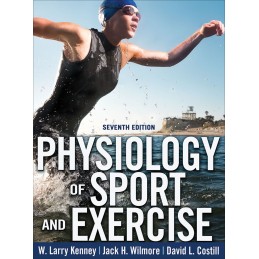Physiology of Sport and Exercise, Seventh Edition With Web Study Guide, continues its legacy as a top physiology textbook and favorite of instructors and students alike. Combining research with extensive visual aids, this resource offers a simple way for students to develop an understanding of the body’s abilities to perform various types and intensities of exercise and sport, to adapt to stressful situations, and to improve its physiological capacities.
Written by a team of distinguished researchers, all past presidents of the American College of Sports Medicine, this seventh edition has been updated based on the most recent position stands, standards, and guidelines in the field of sport and exercise physiology. Throughout the text, updated photos join with the superb illustrations and medical artwork to clarify difficult concepts and illustrate how the body performs. Digital components found in the web study guide now include 26 animations that offer a dynamic way to experience physiological concepts, and 66 audio clips that provide explanations of complex physiological processes to aid students’ understanding of important illustrations in the text. Leaders in the field discuss recent developments and real-world applications in 27 video clips to help students connect theoretical and practical concepts. Corresponding icons throughout the text notify students when digital elements are available to complement the materials.
In addition to the expanded digital components,
Physiology of Sport and Exercise, Seventh Edition, features new and updated content based on the latest research in the field::
- Additional information on overtraining and exercise addiction
- Expanded content on fatigue and mobility in aging
- New sections on epigenetics, bioinformatics, and neuromuscular function
- New information on exercise genomics
- New Research Perspectives emphasizing emerging findings in the field, and a new Research Perspectives Finder to help students locate key content quickly
Ease of reading has been the standout feature of this popular text. The seventh edition continues to offer comprehensive coverage of the complex relationship between human physiology and exercise while maintaining an engaging and student-friendly tone. Unique learning features paired with an accessible layout, including chapter-opening outlines and review boxes throughout each chapter, will help students focus on the major concepts addressed. Study questions and a list of key terms at the end of the chapter increase students’ opportunities for recall and self-testing. A comprehensive glossary and lists of common abbreviations and conversions provide easy reference for students as they complete labs and assignments.
To foster an enriched learning experience, both students and instructors can take advantage of the web-based ancillaries that accompany the text. In addition to animations, videos, and audio clips, the web study guide includes comprehension quizzes to provide immediate feedback to students on their knowledge retention as well as end-of-unit mastery checks that students can use for evaluating their progress.
Instructors are provided with access to an instructor guide, test package, ready-to-use chapter quizzes, and a presentation package plus image bank. The presentation package includes PowerPoint slides with key points and content, which can be modified to suit a variety of class structures. An image bank features all of the graphics, artwork, and content photos from the text for easy insertion into tests, quizzes, handouts, and other course materials. Digital extras—composed of the animations, videos, and audio clips that students find in the web study guide—bolster comprehension of challenging concepts.
Physiology of Sport and Exercise has been a pivotal textbook of the engaging field of exercise physiology. Through dynamic and interactive learning activities, easy-to-follow layouts, and research-oriented content enriched with visual supplements, students and instructors will find this an invaluable resource for their continued education.




 Delivery policy
Delivery policy
 Security policy
Security policy
 Return policy
Return policy
